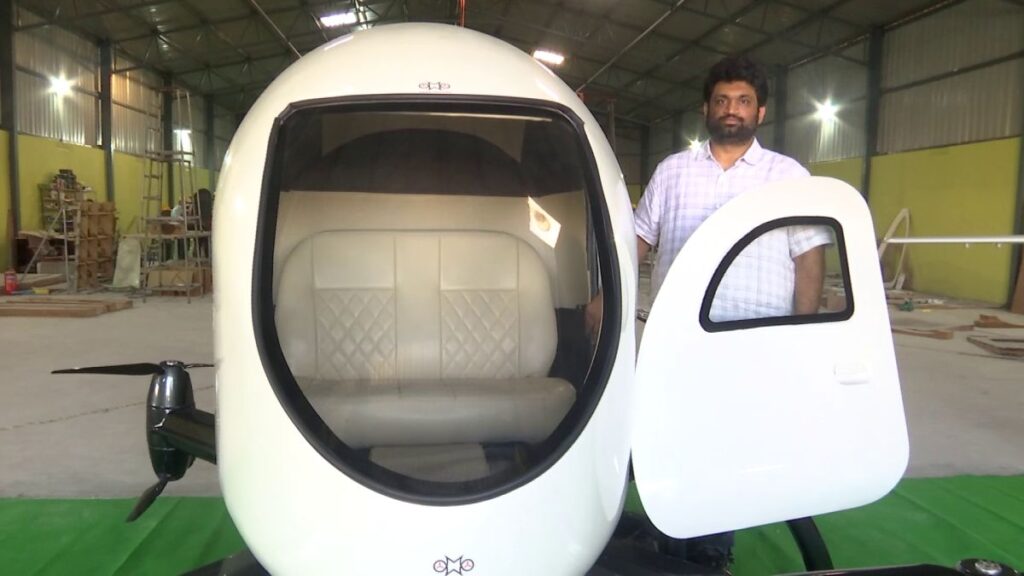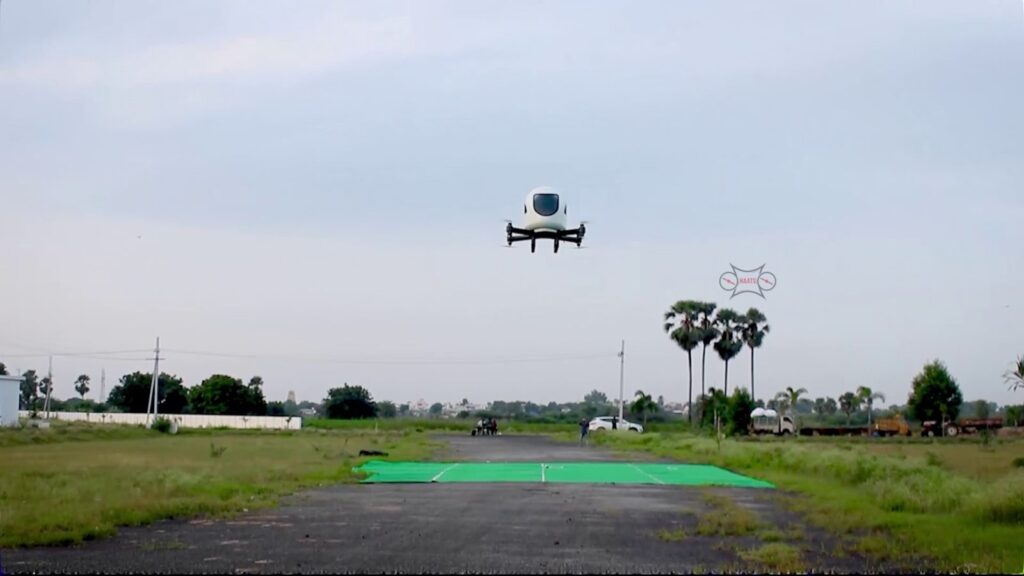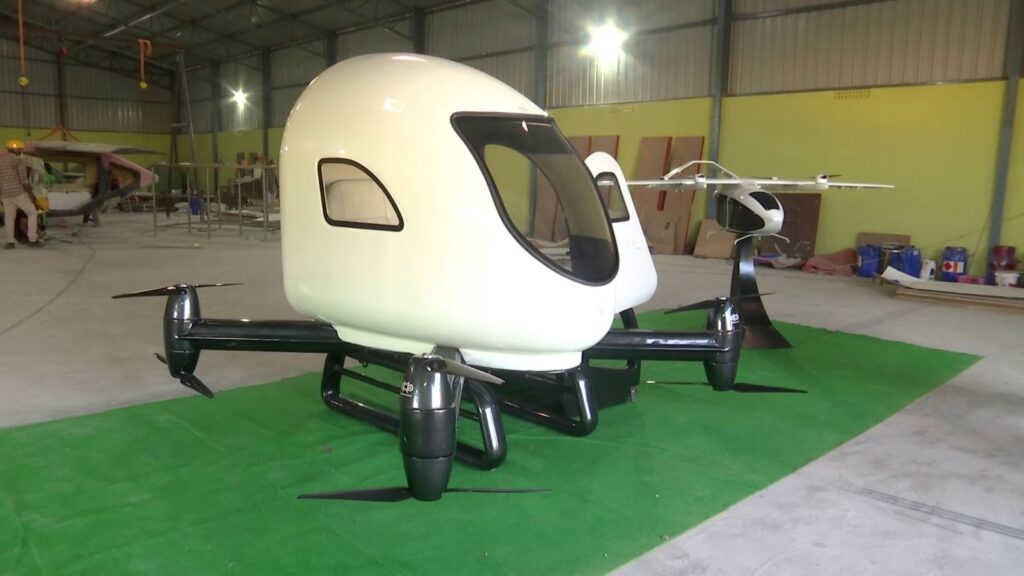Guntur (AP): Flying cars and air taxis have been a fantasy for the longest time. While the technology to make vehicles fly exists in one form or another, such vehicles are still waiting for widescale commercialisation. Countries around the world are trying to improve the technology to make aerial vehicles a common sight. While countries like China currently lead this race, a young man from Guntur, Andhra Pradesh, is determined to compete on a global level by making air taxis a reality.
The two-seater variant of the air taxi has been a success, showcasing a maximum range of 40 km and a top speed of 100 kmph at an altitude of 1,000 feet. The next step for the experiment is a three-seater model. What sets this project apart is its unique focus on local production where all the equipment, except the motor, is being manufactured in Andhra Pradesh.
Air Taxi from Guntur
Chava Abhiram, a native of Guntur, completed his Master’s in Robotics Engineering in the United States. With a vision to establish an institution in India, he identified the potential of introducing air taxis in cities plagued by traffic congestion. After conducting thorough research on the advancements in air taxi technology both domestically and internationally, he founded Magnum Wings in 2019. The company operates out of Nallacheruvu, on the outskirts of Guntur, where he successfully built a prototype of a small air taxi.

Chava Abhiram completed his Master’s in Robotics Engineering in the US (ETV Bharat)
The initial vehicle, designed to be operated remotely without a pilot, achieved a successful launch. However, as per the Directorate General of Civil Aviation (DGCA) regulations, pilotless vehicles are not permitted. To comply, Magnum Wings is developing air taxis with two and three seats to include a pilot. Notably, all components for these projects, except for the motors, are being locally sourced and manufactured in India.

The V2 air taxi model offers a range of 40 km and can reach a top speed of 100 kmph while operating at an altitude of 1,000 feet (ETV Bharat)
The two-seater model, named V2, has undergone successful experimentation, leading to the development of a second version. The three-seater model, X-4, is expected to undergo testing in the coming months.
Air Taxi Travel at Cab Cost
The V2 air taxi model offers a range of 40 km and can reach a top speed of 100 kmph while operating at an altitude of 1,000 feet. In contrast, the three-seater X-4 model is being designed for long-distance travel, covering up to 300 km at an altitude of 20,000 feet, with a maximum speed of 300 kmph.
| Model | Range | Top Speed | Altitude | Seating Capacity | Pricing |
|---|---|---|---|---|---|
| V2 | 40 km | 100 km/h | 1,000 feet | Two-seater | Rs 2 crore |
| X-4 | 300 km | 300 km/h | 20,000 feet | Three-seater | Rs 8 crore |
The pricing for these models is set at Rs 2 crore for the V2 and Rs 8 crore for the X-4, Chava Abhiram revealed, adding that the goal is to make air taxi travel as affordable as cab travel. “These vehicles are powered by batteries, and their maintenance costs remain low due to the shorter distances travelled through the air,” he added.
Air Taxi Policy in the Drafting Stage
Air taxis are being looked at as a solution to urban congestion, offering faster and more efficient travel options. In India, experiments with air taxis are underway in cities like Bangalore and Chennai. However, the air taxi policy is currently in the drafting phase with the Directorate General of Civil Aviation (DGCA) working on policies and guidelines, including the establishment of vertiports— specialised hubs for vertical take-off and landing (VTOL) aircraft.

Magnum Wings is also developing a three-seater X-4 model (ETV Bharat)
Once the necessary formalities are completed, the approval process will commence, paving the way for the start of air taxi services. The entire process is expected to take around three years. Abhiram’s Magnum Wings not only plans to provide air taxi services but also to sell these vehicles to interested buyers.
Vertical take-off and landing (VTOL) aircraft
Several startups in India have been working on VTOL aircraft development for air taxis. Earlier this year, a flying taxi prototype ‘Shunya’, developed by Sarla Aviation in collaboration with Sona SPEED, was showcased at the Bharat Mobility Global Expo 2025 and Invest Karnataka 2025. The company plans further test flights and prototypes for the eVTOL aircraft and eyes a market launch by 2028.
Similar efforts are being made in other countries. Last year at the Consumer Electronics Show (CES 2024), Hyundai Motor Group’s Advanced Air Mobility company, Supernal, unveiled its S-A2 electric vertical takeoff and landing (eVTOL) vehicle concept. The pilot-plus-four-passenger V-tail aircraft has been designed for urban trips ranging from 40 km to 64 km, cruising at around 190 kmph speed at an altitude of 1,500 feet.
